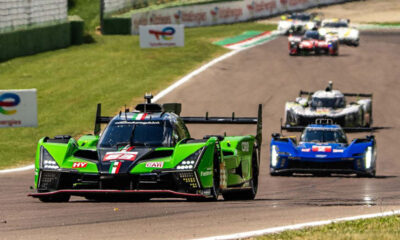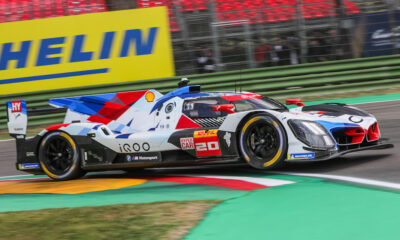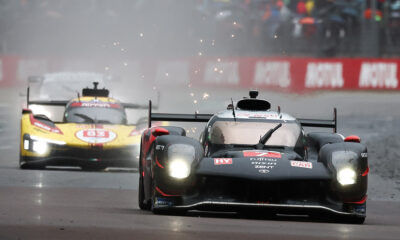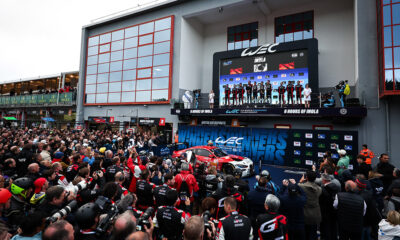
Photo: MPS Agency
Panis-Barthez Competition team manager Simon Abadie believes the launch of the FIA World Endurance Championship’s Hypercar class is happening “one year too early” amid concerns in likely performance reductions to the current-generation LMP2 cars.
The WEC’s yet-to-be-named top class has been targeted to produce 3:30 lap times in race pace at Le Mans, some ten seconds per lap slower than LMP1 machinery and five seconds slower than current-generation LMP2 cars, which were introduced in 2017 with technical regulations locked in through 2020.
With the WEC’s shift to a winter calendar and the planned introduction of Hypercars for 2020-21, it will result in at least one season where the two platforms will co-exist.
The ACO has yet to confirm any performance-related changes to LMP2 machinery, which is due for a regulations refresh in 2021, as its focus has remained on finalizing the Hypercar package first, according to sporting director Vincent Beaumesnil.
While supportive of the overall Hypercar concept, Abadie has questioned the timing of the platform’s launch, which is also likely to see OEM involvement limited to Toyota and Aston Martin only for the initial season.
“It’s a very good idea to make the Hypercar race car with the same look as the normal road car,” Abadie told Sportscar365. “I think it’s very important to have the same design for the people.
“But I think that they have taken the decision too early.
“For me, the manufacturers don’t have any time. Maybe Toyota is working a lot, but maybe in 2021-22 we have maybe Porsche or Audi or other manufacturers come in with better development.
“They have taken the decision one year too early [to begin the class].
“I hope they find the solution because it’s important to find one for the ELMS, for WEC and for Le Mans.
“But when I speak with my staff and my engineers, when we do the simulations, they say it’s very difficult for Hypercar to arrive at Le Mans at [a higher performance than] LMP2.”
Abadie said he sees “three possibilities” of methods to slow down the current-gen LMP2 cars in order to put them behind Hypercar’s projected performance levels.
“One, have less horsepower and put more weight on the car, or you put on harder tires,” he said. “The harder tire is the easiest to make [the cars] slower, but the program for the championship is very difficult to drive with hard tires.
“And also, we would have to start with [tire] blanketing for WEC, so the price would go up. It’s easier, but more expensive for the season.
“[Weight-wise], we are nearly on the limit for crash testing. Maybe for 20 kg, it’s more or less OK, if you add 20 kg you are more or less five-tenths off. Can we crash test perfectly with the car? That is the question.
“With 50 horsepower lost, you lose four or five seconds. But then the problem is that we cannot overtake the GTE cars.
“It’s now the question of what happens with Hypercar. They are not like LMP1 or LMP2, but in between. The manufacturers hope to lap in 3:25 at Le Mans (qualifying pace), and us in the 3:30s.”
Should LMP2 cars be slowed, it would conversely affect the GTE classes, and in the case of ELMS, the LMP3 platform as well, according to Abadie.
“I don’t know what is happening with this balance,” he said. “It’s not easy.
“The problem for ELMS is that you get slower compared to LMP3, and the GTEs [also] get slower. And the price is huge between the two categories. Toyota and Aston Martin don’t want to fight a smaller team like us or Jota, or United [for overall wins].
“But I hope that Hypercar works very well and that we have some manufacturers to come to give more [opportunities for promotion] to LMP2 drivers.”
De Chaunac: ORECA in “Wait and See” on LMP2 Developments
ORECA President Hugues de Chaunac is taking a “wait and see” approach on what changes will be made to LMP2 machinery, stressing that the category does not need a complete overhaul due to the level of current investment from customers.
“One factor is the economical parameters of the team,” he told Sportscar365. “Normally, we want to reduce the budget in racing, generally speaking. The teams don’t want to invest in new cars and new spare parts.
“The best thing on the economical aspect is probably to repeat the LMP2 regulations, because most of the teams have their cars and spare parts but are not going to expand. They want to reduce their budgets.
“If you look at the IndyCar system, they have had the same cars for ten years. So this is one option, to change nothing because it allows the team to spend less money.
“We also have the option to have a new [set of] regulations but I don’t think it’s good for the economic situation of the teams – not car manufacturers. If we have to send new cars, it’s perfect for us, but I don’t think it will be for the teams.”
Daniel Lloyd contributed to this report























